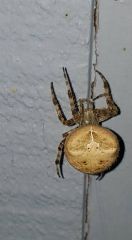Cat Faced Spider
Araneus gemmoides
Taxonomy: Arthropods (Arthropoda) » Chelicerates (Chelicerata) » Arachnids (Arachnida) » Spiders (Araneae) »True Spiders (Araneomorphae) » Entelegynes » Orb Weavers (Araneidae) » Araneus » Cat-Faced Spider (Araneus gemmoides)Physical Description
You would think the cat-faced spider would be a somewhat cute species of spider much like the adorable Tan Jumping Spider or, technically speaking, Platycryptus Undatus. Unfortunately, this is not the same case. However, the Cat-Faced Spider is still very unique nonetheless. Its abdomen is very large and dimpled with markings that resemble a cat’s face. It also has a white line that goes down the middle of the abdomen that has two V shapes overlapping the line. Its colors range from a light straw-brown to a dark greyish-brown. They're also known for the two horn shapes that rises on the abdomen.Spider Size
Females can get as long as 5-7mm and as wide as 4.5-5.5mm. Males are much smaller in most cases, normally only measuring up to half the size of the female [source].Location
They are found in the western region of North America. They prefer to spin their webs in bushes, trees, or near buildings particularly near outside lighting to get the full advantage of their prey. They tend to hide under a near leaf or branch until they feel a web vibration to which they retreat back and wrap up their prey.Who are they related to?
These spiders are a part of the huge Orb-Weaver family. The Orb-Weaver family has a wonderful reputation throughout North America for spinning their beautiful circular and stoked webs, being a natural pest control amongst our yards, and being mild-tempered and non-venomous to humans. Though, that only applies to the species we have documented. The famous children’s book, ”Charlotte’s Web” was actually modeled after an Orb-weaving spider.Predators
The most reoccurring predator the Cat-faced spider may have is the black and yellow mud dauber (which paralyzes the spider via sting), birds, and other larger miscellaneous insects. But interestingly enough, cat-faced spiders instinctively hurt their own species by eating its own sibling spiderlings as they grow together, meaning not many spiderlings actually make it to maturity. [source]Diet
It will eat practically any insect that gets stuck in its web such as flies, grasshoppers, other spiders. small honey bees and more! Interestingly enough,it will even eat its brothers and sisters before maturing. [source]Type Of Web
They spin Orb webs which is obvious with them being a part of the orb-weaver family. These webs start from the center and work their way out into a beautiful circular, spoked web. They tend to build these webs everyday and like to work during the evening hours and they’re inactive during the day. They tend to find a single spot to create their web even when destroyed.Harmful to Humans?
The Cat-Faced Spider may look big and bizarre, however it is harmless much like the rest of it’s orb-weaver family. The likeliness of a person being bitten is very slim because these spiders are very meek and mild-tempered, but if it does occur, there should be no worries. Though the bite may pinch, the spider will either not even pierce the skin, or the venom won’t be strong enough to hurt a human. These spiders are actually very useful because they keep control over the fast growing population of the lawn and garden pests.Other Names
Araneus Gemmoides, The Western Plains Orb-Weaver, and the Monkey-faced Spider, Jewel Spider.External links:
http://www.wci.colostate.edu/Assets/pdf/Cat-FacedSpiderOct16.pdf
https://en.wikipedia.org/wiki/Orb-weaver_spider#The_orb-web
http://entomology.wsu.edu/outreach/bug-info/cat-face/


